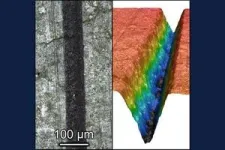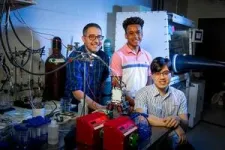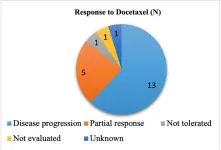(Press-News.org) CHAMPAIGN, Ill. — To achieve more effective saltwater desalination, mechanical engineers focused on fluid movement rather than new materials in a new study. By adding microchannels to the inside of battery-like electrodes made of Prussian blue – an intense blue pigment often used in art that also has special chemical properties – researchers increased the extent of seawater desalination five times over their non-channeled counterparts to reach salinity levels below the freshwater threshold.
The study, led by University of Illinois Urbana-Champaign mechanical engineering and science professor Kyle Smith and graduate student Vu Do, used a chemical analog to Prussian blue. The findings are poised for applications in desalination, energy conversion and storage, CO2 conversion and capture, environmental remediation, and resource and nutrient recovery.
The study is published in the journal Energy and Environmental Science.
“In previous work, we predicted desalination could be performed using this method, but nobody had validated seawater-level desalination in the lab,” Smith said. “In the interim, we learned that in addition to the specific kind of material used in the electrodes, the system’s configuration also matters.”
The researchers said the Prussian blue analog material works by taking hold of positively charged ions like sodium within the pigment’s crystal structure. However, it can turn into a bit of a traplike structure, where the ions easily enter but become ensnared in a maze of tiny, charged molecular-scale pore spaces inside the electrode. The team found that they would need to use a specialized apparatus to perform complex valve switching and current synchronization inside the flow cell to keep continuous desalination going, without which the system’s efficiency is hampered.
By engraving multiple 100-micrometer wide channels – the approximate width of a human hair – onto the 5-centimeter-sized electrode, the researchers can provide the fluids with a clear path to pass through without losing the ability to pluck salt ions out of the water, the researchers said.
The setup used for this study can desalinate laboratory-prepared seawater at a rate of milliliters over the course of hours, so the team’s next step is to scale up, the researchers said.
“The goal of the Navy grant used to fund this study is to desalinate two to four gallons per hour – using diesel fuel as a power source – to provide a portable device to supply water to military troops in small expeditionary units,” Smith said. “Of course, our group is interested in much broader applications for these battery-like devices, but scaling up will be an essential step to getting there.”
“One remarkable aspect of this study is the mechanical engineering edge that we provide,” Do said. “In the research community, there’s a lot of emphasis on materials and their chemistry. But we’ve shown that fluid mechanics of the system matter a lot to get the most out of a great material when you integrate it appropriately.”
Smith research group members Irwin Loud and Erik Reale also contributed to the study.
The U.S. Office of Naval Research, the National Science Foundation and the
department of mechanical science and engineering at Illinois support this research. Smith also is affiliated with the Beckman Institute for Advanced Science and Technology at Illinois.
Editor’s notes:
To reach Kyle Smith, call 217-300-0928; email kcsmith@illinois.edu.
The paper “Embedded, micro-interdigitated flow fields in high areal-loading intercalation electrodes towards seawater desalination and beyond” is available online. DOI: 10.1039/D3EE01302B
END
Mechanical engineers lend fresh insight into battery-based desalination technology
2023-06-07
ELSE PRESS RELEASES FROM THIS DATE:
Alcohol drinking cut in half with diabetes medication
2023-06-07
Semaglutide is sold under brand names such as Ozempic. Since this medication was also approved for the treatment of obesity, demand has increased, which has resulted in difficulties in procuring the drug in recent times. There is anecdotal evidence of patients with obesity or diabetes saying that their craving for alcohol has lessened since they started taking the drug.
Today, individuals with alcohol dependence are treated with a combination of various psychosocial methods and medications. Four approved medications are available. Since alcohol dependence is a disease with many causes, the efficacy of these medications varies, and so it is important that we develop additional treatment medications.
Reduced ...
Detection dog can sniff out highly-endangered great crested newts
2023-06-07
A trained detection dog was highly accurate at finding great crested newts underground or at a distance, which might aid conservation efforts for this highly-endangered species, according to a study published June 7, 2023 in the open-access journal PLOS ONE by Nicola Jayne Glover from the University of Salford, UK, and colleagues.
The highly-endangered great crested newt (Triturus cristatus) is a species of special conservation concern across the UK and central and northern Europe. While much is known about the great crested newts’ aquatic life phase, comparatively little is known about their terrestrial ...
Paris will host the 25th International Conference of the Redox Medicine Society with 61 communications this June in Paris
2023-06-07
The 25th International Conference on Redox Medicine 2023 which will be held in Paris on June 1-2 will welcome 61 communications (major, short and poster presentations), and gather international in-person and virtual participants from 31 countries.
Redox Medicine 2023: What are the recent advances and perspectives?
On its 25th anniversary, Redox Medicine 2023 will be held to bring together academic and industry experts in redox to discuss advances and recent innovation in this vast field.
The new president of the Redox Medicine Society, Dr. Carole Nicco, Université ...
Ancient genomes show that the farming lifestyle in northwestern Africa was ignited by oversea-migrants from Iberia 7,400 years ago
2023-06-07
A genomic analysis of ancient human remains from Morocco in northwest Africa revealed that food production was introduced by Neolithic European and Levantine migrants and then adopted by local groups. A research team from Sweden, Spain and Morocco present their results in Nature on June 7th.
In northwestern Africa, lifestyle transitioned from foraging to farming some 7,400 years ago, but what sparked that change remained unclear. Previous studies support conflicting views: that migrant European Neolithic farmers brought the new way of life to North Africa, or that local hunter-gatherers adopted farming practices.
“We found a remarkable population continuity ...
Calculation shows why heavy quarks get caught up in the flow
2023-06-07
UPTON, NY—Using some of the world’s most powerful supercomputers, a group of theorists has produced a major advance in the field of nuclear physics—a calculation of the “heavy quark diffusion coefficient.” This number describes how quickly a melted soup of quarks and gluons—the building blocks of protons and neutrons, which are set free in collisions of nuclei at powerful particle colliders—transfers its momentum to heavy quarks.
The answer, it turns out, is very fast. As described in a paper just published in Physical Review Letters, the momentum transfer from the “freed up” ...
Bilingual, digital health tool helps reduce alcohol use, UC Irvine-led study finds
2023-06-07
Irvine, Calif., June 7, 2023 –– An automated, bilingual, computerized alcohol screening and intervention health tool is effective in reducing alcohol use among Latino emergency department patients in the U.S., according to a study led by the University of California, Irvine.
“This is the first bilingual, large-scale, emergency department-based, randomized clinical trial of its kind in the country focused on English- and Spanish-speaking Latino participants,” said lead author Dr. Federico Vaca, UCI professor of emergency medicine. “Our aim was to overcome well-known barriers to alcohol screening and intervention from the emergency department while ...
Value of chemotherapy post immunotherapy in stage IV non-small cell lung cancer
2023-06-07
“[...] large multicenter prospective randomized trials are needed to provide the clinical evidence for the use of [chemotherapy] in second line and third-line post [immunotherapy] failure.”
BUFFALO, NY- June 7, 2023 – A new research paper was published in Oncotarget's Volume 14 on May 26, 2023, entitled, “Value of chemotherapy post immunotherapy in stage IV non-small cell lung cancer (NSCLC).”
Lung cancer is the number one cause of mortality among all types of cancer worldwide. Its ...
Pioneer of multicore processor design receives the ACM-IEEE CS Eckert-Mauchly Award
2023-06-07
ACM, the Association for Computing Machinery, today announced that Kunle Olukotun, a Professor at Stanford University, is the recipient of the ACM-IEEE CS Eckert-Mauchly Award for contributions and leadership in the development of parallel systems, especially multicore and multithreaded processors.
In the early 1990s, Olukotun became a leading designer of a new kind of microprocessor known as a “chip multiprocessor”—today called a “multicore processor.” His work demonstrated the performance advantages of multicore processors ...
Using genomics to unlock the full potential of industrial hemp
2023-06-07
Plant biologist Alex Harkess, PhD, and his lab at HudsonAlpha Institute for Biotechnology are on a mission to change the future of food and fiber crops, one flowering plant species at a time. Much of plant breeding and global food production relies on the pollination of flowers to produce fruits that are eaten and used to produce further progeny. This process might sound straightforward, but it is actually complicated by the fact that some flowers contain only male or female reproductive organs, others contain both (hermaphrodites), and some can even switch sexes.
How flowers become male, ...
MD Anderson Research Highlights for June 7, 2023
2023-06-07
HOUSTON ― The University of Texas MD Anderson Cancer Center’s Research Highlights showcases the latest breakthroughs in cancer care, research and prevention. These advances are made possible through seamless collaboration between MD Anderson’s world-leading clinicians and scientists, bringing discoveries from the lab to the clinic and back.
Recent developments include a molecularly driven Phase I trial of the ATR inhibitor camonsertib, an artificial intelligence model to predict immunotherapy responses in lung cancer, an analysis of cognitive and functional outcomes following treatment ...









